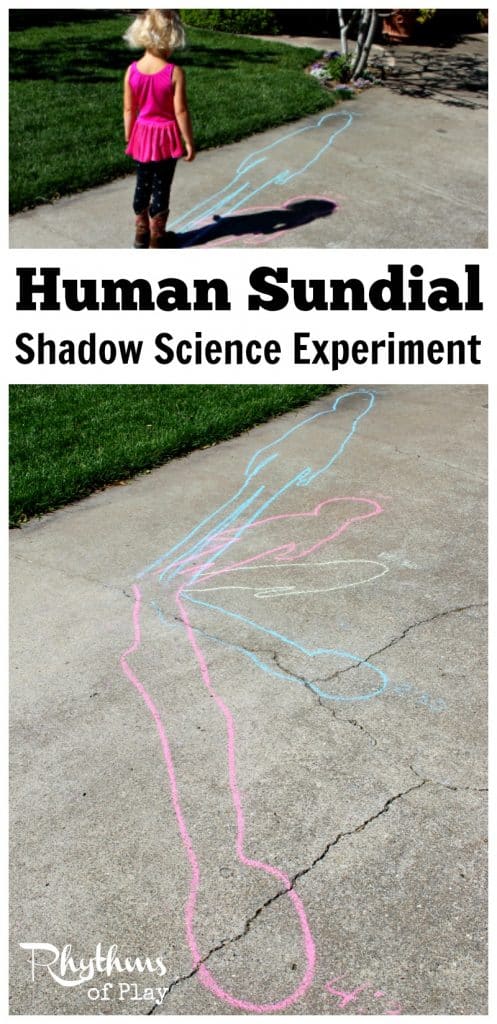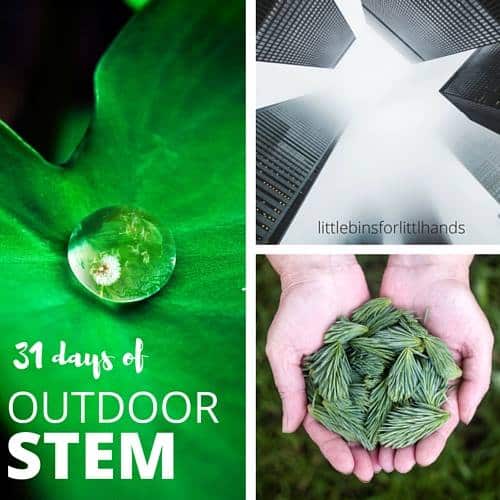

This post contains affiliate links for your convenience. Thank you for choosing to support this blog!
Human Sundial Shadow Science Experiment Materials
- Open space with no shadows and no clouds overhead. Driveways, parking lots, and playgrounds work well.
- Scientific Notebook and pen or pencil to record observations
Human Sundial Shadow Science Experiment Procedure
1. Choose a sunny day with no clouds or rain/snow expected. If clouds move in during the day you will have to scrap your human sundial shadow science for another day.
2. Find an open cement or asphalt area near you home where the sun shines most if not all day so you can become a human sundial. Driveways, parking lots, and playgrounds work well. Make sure you have enough space in all directions around you, shadows can grow long! If there are trees or structures near the area you are considering, check the area in the morning, at mid-day, and in the evening to make sure that the area is not shadowed at any time of the day. You need the sun on it to be able to trace your child’s shadow! If you are doing this with a class make sure the children are spread far enough apart. You will need about 20-30 feet between students.
3. Place an ‘X’ on the spot that your child will stand each time they have their shadow traced.
4. Use sidewalk chalk to trace your child’s shadow at least 3 times throughout the day. If you are working with a class have them trace each other’s shadows. Morning, mid-day, and late afternoon/early evening work great. Think of mealtimes as your cue to trace shadows, or set an alarm to go off. We did our shadow tracings every two hours at 8:30am, 10:30am, 12:30am, 2:30pm, and 4:30pm.

5. Note the time and the location of the sun in the sky in your notebook when you make each tracing.
6. Use sidewalk chalk to write the time it was taken next to each tracing.
7. Have children describe their shadows each time the take it. (long and skinny, short and fat, etc.) Have them record this observation in their notebook.
8. Measure the length of your child’s shadow each time you trace it and record it in your notebook.
9. Have them predict where their shadow will be after the second tracing. (They will need to see that their shadow moved before you can ask them to predict where it will move next.
10. Take photo’s and/or record all other observations in a scientific notebook.
11. Invite child to compare observations and formulate a hypothesis.
12. To extend the activity conduct this experiment on or around each solstice and equinox to record the differences. Taking photographs and recording your observations in a scientific notebook is a good way to do this.

Human Sundial Shadow Science Experiment: Questions to Ask
Use this activity as a platform to discuss why the shadow changes throughout the day and throughout the rest of the year. Ask your kids the questions below to get them thinking. Later you can explain that our earth spins on its axis in a day and makes its way around the sun in a year to produce the changes that we see in our shadows.
Questions to ask your kids during and after the experiment:
- How do you think shadows are made?
- What did you observe about your shadow and the sun?
- Did the sun move? If yes, which direction?
- In what direction did your shadow move?
- Are the tracings the same? Why or why not?
- When was your shadow the longest? When was it the shortest?
- Why do you think that your shadow changes throughout the day?
- Do you think that your shadow also changes throughout the year?
Human Sundial Shadow Science Experiment: Recommended Reading
Human Sundial Shadow Science Experiment: Our Process
I had a hard time finding a space in our driveway that would work for this experiment. We have shadows falling from here and there all day long so I watched the sun for a few days to find a spot that would work.
We did our shadow tracings at 8:30am, 10:30am, 12:30am, 2:30pm, and 4:30pm. We would have done one last one at 6:30 if our house did not completely shadow the driveway at that time.
I love our photographs because they not only document the changes in her shadow but the changes in her wardrobe throughout the day-ha! Those toddlers are funny aren’t they?

My daughter was only 3 when we tried this for the first time. She was too young to do some of the steps such as recording her observations in a science notebook so I asked her questions and wrote down her responses. The questions I asked dovetailed off her responses and lead her to the conclusion that we (Planet Earth) are the one’s that are moving to produce the changes in our shadows throughout the day and year. She didn’t quite get it yet but it sure was fun!
Since that day I have begun to help her understand that the earth rotates to make day and night. I have also begun to teach her how to tell time and what that means as it relates to the sun and the earth. Fun stuff!
Human Sundial Shadow Science Experiment Conclusion
Help your children learn about the rotation of the earth by tracing shadows throughout the day with this human sundial shadow science experiment. An easy hands-on way for kids to learn about how shadows are created and measure the earth’s rotation.

More Outdoor Science Activities
This post is a part of the 31 Days of Outdoor STEM hosted by Little Bins for Little Hands. Be sure you head over there to see all of the other fun activities you can try!
Original article and pictures take http://www.rhythmsofplay.com/human-sundial-shadow-science-experiment/ site
Комментариев нет:
Отправить комментарий